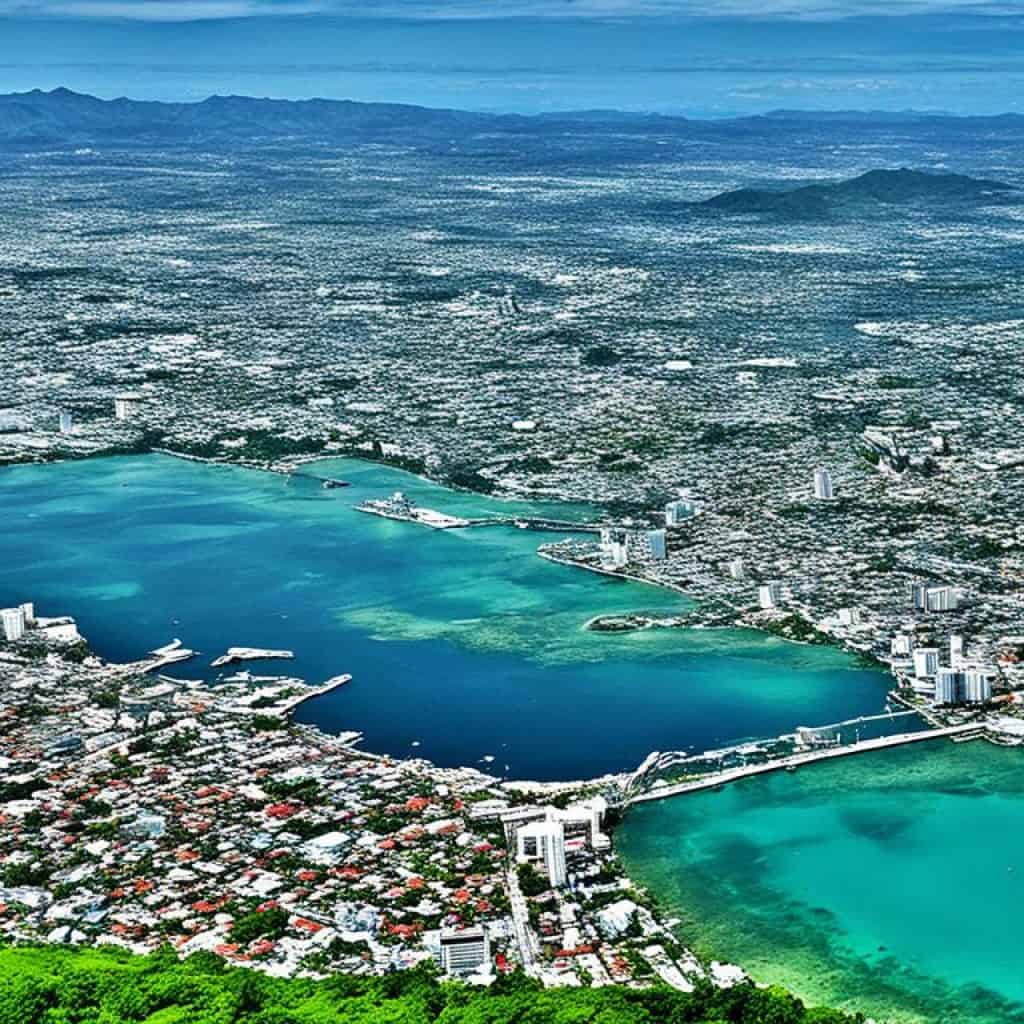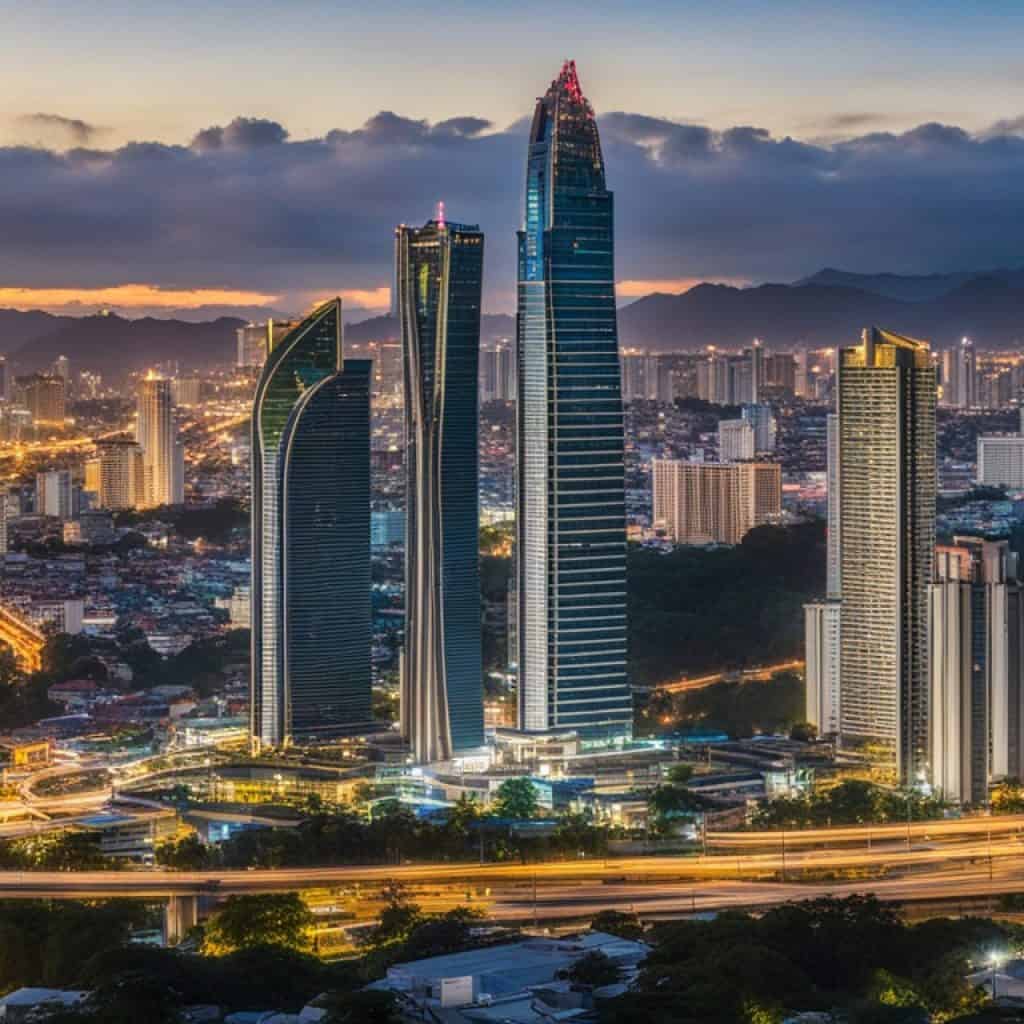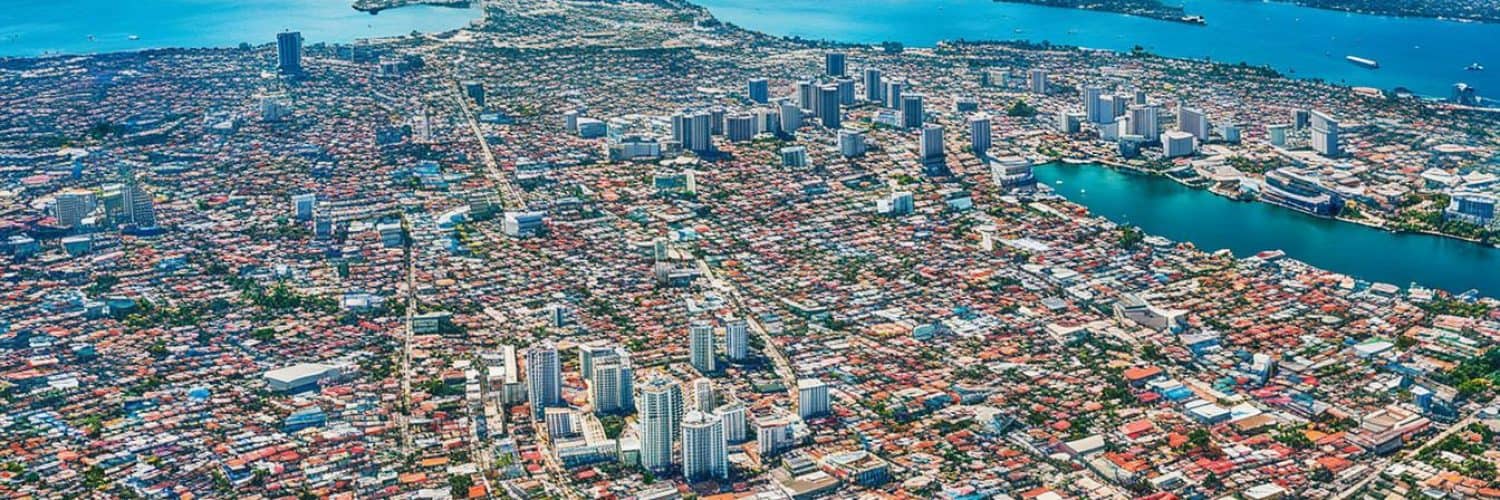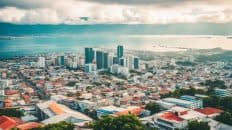Have you ever wondered how a small fishing village in the Philippines transformed into a booming metropolitan area? Brace yourself as we unravel the fascinating growth story of Cebu City, the Queen City of the South, located in the Central Visayas region.
Cebu City has experienced rapid economic growth since the 1990s, cementing its position as a key player in the country’s development. As of 2024, the metro area population of Cebu City is projected to reach 1,043,000, with a 1.76% increase from the previous year. This vibrant urban hub has a thriving community and serves as the regional center of Central Visayas.
Key Takeaways:
- Cebu City’s population is on a steady growth trajectory, with a projected population of 1,043,000 in 2024.
- The city has experienced rapid economic growth since the 1990s.
- Cebu City is known as the Queen City of the South and serves as the regional center of Central Visayas.
- The population of Cebu City has been steadily increasing, with a growth rate of 1.72% in 2020.
- Stay tuned as we delve into the historical population data and compare Cebu City’s statistics with other cities in the Philippines.
Historical Population Data of Cebu City
Cebu City, with its rich history and cultural significance, has witnessed remarkable population growth over the years. In 1950, the population of Cebu City stood at 178,256, marking the beginning of its journey towards urbanization. Fast forward to 2024, and the population has soared to 1,043,000, reflecting a steady growth rate of approximately 1.7% per year. This consistent population growth trend is a testament to the city’s economic development and increasing urban appeal.
Throughout the decades, Cebu City has transformed from a modest fishing village to a bustling metropolis, attracting individuals from various walks of life. The city’s allure lies not only in its economic opportunities but also in its deep-rooted cultural heritage. With each passing year, the population continues to surge, driving the city’s economic expansion and urban landscape.
As displayed in the visual representation above, the population of Cebu City has experienced significant growth over time. This upward trajectory showcases the city’s ability to adapt and evolve, making it a vibrant and thriving destination for both residents and visitors.
Comparison with Other Cities in the Philippines
When it comes to population, Cebu City stands among the most populated cities in the Philippines. With a population of 1,043,000, it ranks as the third-most populous city in the country. The most populous city is Manila, the capital, with a staggering 14,942,000 residents. Cebu City surpasses cities like Davao City, which has a population of 1,991,000, and Zamboanga City, with 977,000 residents. The population density of Cebu City is approximately 3,100 people per square kilometer.
To put these numbers into perspective, let’s take a closer look at the population density. The city’s population density reflects its vibrant urban environment and the influx of residents. With around 3,100 people per square kilometer, Cebu City is a bustling hub with a diverse and active community.
To better understand the scale of Cebu City’s population, let’s compare it to other major cities in the Philippines. The following table provides a comparison of population statistics:
| City | Population |
|---|---|
| Manila | 14,942,000 |
| Davao City | 1,991,000 |
| Cebu City | 1,043,000 |
| Zamboanga City | 977,000 |
As you can see, Cebu City holds a significant population and ranks high among the most populous cities in the Philippines. Its dynamic and vibrant community contributes to its economic growth, cultural diversity, and overall appeal.
The image above visualizes the population density of Cebu City, emphasizing the concentration of residents in the urban landscape. This concentration of people fuels the city’s energy, opportunities, and lively atmosphere.
Urbanization and Economic Importance of Cebu City
Cebu City, one of the thriving urban centers in the Philippines, plays a crucial role in the country’s economic development. As the main domestic shipping port, it facilitates the smooth flow of goods and commodities, driving commerce and trade in the southern part of the country. The city’s strategic location and excellent transportation networks have made it a preferred trading center for both local and international businesses.(cebu city economic growth)
The rapid urbanization of Cebu City has spurred significant growth in various sectors, contributing to its economic importance. The city has witnessed a remarkable expansion in industries, including manufacturing, information technology, tourism, and creative arts. The entrepreneurial spirit and vibrant business environment attract investors and entrepreneurs seeking new opportunities and growth potential.
Education and healthcare have also experienced a surge in development, keeping pace with the city’s rapid urban growth. Cebu City is home to prestigious educational institutions and renowned healthcare facilities, ensuring access to quality education and healthcare services for its residents and visitors alike.
“Cebu City embraces its role as the Creative Capital of the Philippines, with a flourishing arts and creative industries sector. From art galleries and theaters to music festivals and design studios, the city’s cultural landscape is pulsating with creativity. The local government actively supports and promotes the arts, making Cebu City a hub of cultural expression and innovation.”
(cebu city urbanization)
Moreover, Cebu City’s growth has not been limited to economic sectors alone. The city has also witnessed a remarkable transformation in its urban infrastructure, with modern buildings, shopping centers, and residential communities adding to its skyline. Development projects, such as the upcoming Cebu-Cordova Link Expressway, reflect the city’s commitment to improving connectivity and providing residents and businesses with advanced infrastructure.
Cebu City’s economic importance extends beyond its borders, as it serves as a model for other cities in the region. Its success in urban planning, economic growth, and cultural vibrancy inspires neighboring cities and contributes to the overall development of Central Visayas.
| Economic Sectors | GDP Contribution (%) |
|---|---|
| Manufacturing | 32% |
| Information Technology | 18% |
| Tourism | 12% |
| Creative Arts | 8% |
The table above highlights the key economic sectors in Cebu City and their respective contributions to the city’s GDP. Manufacturing takes the lead with a substantial 32% contribution, followed by the information technology sector at 18%. The booming tourism industry and the city’s vibrant creative arts scene make significant contributions of 12% and 8%, respectively.
Geography and Location of Cebu City
Cebu City, a bustling urban center in the Philippines, is situated along the eastern seaboard of Cebu Island. Known as the Queen City of the South, it boasts a strategic location that contributes to its economic and transport significance. Spanning an area of 315 square kilometers, Cebu City is bounded by various cities and towns, including Talisay to the south, Mandaue and Lapu-Lapu to the east, and Balamban and Danao to the north.
Surrounded by stunning natural landscapes and nestled amidst the vibrant Visayan region, Cebu City offers a vibrant blend of urban development and coastal charm. Its accessibility, thanks to well-connected transportation networks and proximity to major trade routes, has made it a key hub for business, commerce, and tourism.

Strategic Location Enhancing Economic Growth and Connectivity
Cebu City’s favorable positioning has played a crucial role in its economic growth and development. As a major economic and transport hub, the city serves as a gateway to both local and international markets. Its location along the Visayan Sea has made it a vital port city, facilitating trade and commerce across the Central Visayas region and beyond.
Proximity to Other Key Cities and Towns
Cebu City’s geographical location places it in close proximity to neighboring cities and towns, fostering interconnectedness and regional cooperation. To the south, the city borders Talisay, a rapidly developing municipality known for its scenic coastal areas and residential communities. In the east, Cebu City is connected to Mandaue and Lapu-Lapu, two highly industrialized cities that further contribute to the economic dynamism of the region. To the north, Cebu City shares boundaries with Balamban and Danao, providing access to diverse landscapes and potential areas for future growth and development.
Metropolitan Area Expansion
While Cebu City itself covers an area of 315 square kilometers, its influence extends much further. The entire metropolitan area of Cebu spans 1,062.88 square kilometers, encompassing not only the city proper but also neighboring municipalities and cities. This expanded area reflects the significant economic, social, and cultural interplay between Cebu City and its neighboring regions.
Cebu City’s Influence in Central Visayas
Cebu City, located in the Central Visayas region of the Philippines, holds significant influence as the regional center of Central Visayas. This group of islands includes the provinces of Cebu, Bohol, Negros Oriental, and Siquijor. Beyond its own metropolitan area, Cebu City acts as a catalyst for economic, cultural, and administrative activities throughout the region.
The city’s status as a regional center attracts numerous regional offices, headquarters, and institutions. These establishments contribute to the growth and development of commerce, trade, industry, education, culture, tourism, and healthcare in Central Visayas. Cebu City serves as a hub, facilitating collaboration and interaction among the provinces and fostering a sense of unity among the communities in the region.
“Cebu City’s influence extends beyond its borders, shaping and driving progress throughout Central Visayas. Its strategic location and vibrant economic environment make it the natural choice for regional activities and partnerships.”
As a regional center, Cebu City provides access to various resources, services, and opportunities for the surrounding provinces. The city’s robust infrastructure, including transportation networks and communication facilities, paves the way for seamless connectivity among different areas in Central Visayas. This interconnectedness fosters economic growth and synergies that benefit all stakeholders within the region.
Furthermore, Cebu City’s influence extends beyond economic and administrative aspects. It also nurtures cultural and social ties within Central Visayas. The city serves as a hub for showcasing the unique traditions and heritage of the region through festivals, exhibitions, and cultural events. These interactions help promote a sense of pride and identity among the residents of Central Visayas, fostering unity and cooperation.
Maximizing Potential Through Collaboration
Cebu City’s role as the regional center of Central Visayas presents an opportunity for collaboration and mutual growth among the provinces. By leveraging each other’s strengths and resources, the region can further enhance its socio-economic development. Collaboration in areas such as tourism, trade, and education can lead to shared success, increased competitiveness, and improved quality of life for the residents of Central Visayas.
Building a Thriving Central Visayas
The influence of Cebu City in Central Visayas speaks to the city’s commitment to regional progress and shared prosperity. As a central hub, Cebu City plays an essential role in driving economic activities, promoting cultural exchange, and fostering collaboration. By harnessing the collective potential of the region, Central Visayas can continue to grow and thrive, creating a brighter future for its residents.
Economic Growth and the “Ceboom” Phenomenon
The 1990s witnessed a remarkable period of rapid economic growth in Cebu City, known as the “Queen City of the South.” This transformational period was appropriately dubbed as the “Ceboom,” signifying the city’s booming economy and unprecedented development.
Cebu City experienced a surge in business and investment during this time, with particular emphasis on the information technology and business process management sectors. Companies flocked to the city, attracted by its skilled workforce, competitive labor costs, and favorable business environment. Local entrepreneurs and international investors recognized the city’s immense potentials and seized the opportunity to establish their presence in Cebu City.
“The Ceboom was a game-changer for Cebu City’s economic landscape. The influx of businesses and investments propelled the city’s development, creating a wealth of opportunities and solidifying its position as a major economic player in the country.”
This economic boom brought about significant positive changes to the city. Infrastructure development gained momentum, with the construction of modern buildings, shopping centers, and residential communities. Ongoing projects, such as the Cebu-Cordova Link Expressway, further enhanced connectivity within the metropolitan area, facilitating greater accessibility and reducing traffic congestion.
Moreover, the Ceboom phenomenon placed Cebu City on the global map as a vibrant economic hub. The city’s reputation as a center for innovation, entrepreneurship, and technological advancements attracted not only domestic investors but also foreign companies seeking to tap into the city’s robust economy.
“Cebu City’s economic importance extends beyond its borders. It has become an attractive destination for investors from all over the world, contributing to not only the city’s growth but also the overall economic progress of the Philippines.”
The Ceboom phenomenon continues to shape Cebu City’s economic landscape, with sustained growth and development in various sectors. The city’s focus on nurturing a business-friendly environment, coupled with its ongoing efforts to improve infrastructure and connectivity, positions Cebu City as a prime destination for both established enterprises and emerging startups looking to thrive in a dynamic and competitive marketplace.
| Key Aspects | Impact |
|---|---|
| Business and Investment | A surge in businesses and investments, particularly in the information technology and business process management sectors. |
| Infrastructure Development | Significant improvements in infrastructure, including the development of modern buildings, shopping centers, and residential communities. |
| Connectivity | Ongoing projects, such as the Cebu-Cordova Link Expressway, enhance connectivity and reduce traffic congestion within the metropolitan area. |
| Global Recognition | The Ceboom phenomenon solidifies Cebu City’s reputation as a center for innovation, entrepreneurship, and technological advancements. |
| Attracting Investors | Cebu City’s economic importance attracts both domestic and international investors, contributing to the overall economic progress of the Philippines. |
Cultural and Tourist Attractions in Cebu City
Cebu City, aside from its thriving economy, is renowned for its vibrant cultural heritage and numerous tourist attractions. Visitors to the city can explore a variety of landmarks that offer insights into its rich history and traditions.
Landmarks and Historical Sites
One popular destination is Magellan’s Cross, a significant historical site where Portuguese explorer Ferdinand Magellan planted a cross upon arriving in Cebu in 1521. This iconic landmark symbolizes the introduction of Christianity to the Philippines.
Cebu Metropolitan Cathedral, located in the heart of the city, is another must-visit attraction. This stunning Roman Catholic church showcases intricate architectural details and holds great religious significance for the local community.
For those interested in religious history, the Basilica del Santo Niño is a significant pilgrimage site. It houses the revered Santo Niño de Cebu, the oldest religious artifact in the Philippines.
Festivals and Cultural Events
Cebu City is famous for its lively festivals that celebrate its vibrant culture and traditions. One such event is the Sinulog Festival, held every January. The festival features dazzling street dances and a grand parade honoring the Santo Niño.
Another notable cultural event is the Kadaugan sa Mactan, which commemorates the historic Battle of Mactan. The festival showcases reenactments, art exhibits, and cultural performances that highlight the city’s local customs and practices.
“Cebu City’s cultural attractions offer a unique blend of history, art, and religious significance that captivates visitors and locals alike.”
Whether exploring historical landmarks or immersing oneself in colorful festivals, Cebu City offers a diverse range of cultural experiences that showcase the heritage and traditions of the Cebuanos.
Infrastructure and Development Projects in Cebu City
As a rapidly growing city, Cebu City is dedicated to improving its infrastructure and implementing various development projects to support its booming economy. One notable undertaking is the Cebu-Cordova Link Expressway, a bridge that will connect Cebu City with Mactan Island. This ambitious project aims to enhance connectivity and alleviate the issue of traffic congestion in the metropolitan area. It will provide a faster and more convenient route for commuters and serve as a catalyst for further economic growth in the region.

The development of Cebu City is not limited to bridges alone. The city has witnessed the construction of modern buildings, shopping centers, and residential communities. These projects contribute to the overall infrastructure improvement and provide new opportunities for business, commerce, and urban living in Cebu City. With its robust development plans, the city is creating a sustainable and vibrant urban landscape that caters to the needs of its growing population.
Investing in infrastructure and development projects is crucial for the continued growth and prosperity of Cebu City. These initiatives not only enhance the quality of life for its residents but also attract more businesses, investors, and tourists to the area. By prioritizing infrastructure development, Cebu City is positioning itself as a dynamic and forward-thinking metropolis in the Philippines.
Social and Economic Challenges in Cebu City
Despite its remarkable economic growth, Cebu City grapples with various social and economic challenges that demand attention and innovative solutions. Rapid urbanization, in particular, has given rise to cebu city social challenges such as increased urban poverty and the proliferation of informal settlements. These challenges pose significant obstacles to the city’s overall development and well-being.
One of the pressing issues the city faces is cebu city economic challenges in the form of traffic congestion. As Cebu City continues to grow and attract more businesses and residents, the strain on existing transportation infrastructure has become evident. Long commuting times and congested roads not only affect the quality of life for residents but also hamper the efficiency of the city’s economic activities. Addressing this challenge requires comprehensive plans for infrastructure improvement and the adoption of sustainable transportation solutions.
“The traffic congestion in Cebu City is a growing concern that hinders both economic productivity and quality of life,” says transportation expert Maria Rodriguez. “To alleviate this challenge, the city needs to invest in efficient public transportation systems, promote alternative modes of transport such as cycling, and explore smart traffic management solutions.”
An inadequate infrastructure system adds to the cebu city social challenges faced by its residents. Insufficient access to basic amenities such as water, sanitation, and healthcare is a prevalent issue, particularly in informal settlements. These substandard living conditions exacerbate the already dire circumstances of poverty and hinder social and economic development opportunities for affected individuals and communities.
“Improving basic infrastructure services is crucial to uplifting the living conditions of residents and addressing social issues,” emphasizes urban planner Juan Gomez. “By investing in upgraded infrastructure, Cebu City can address the needs of its growing population and pave the way for sustainable urban development.”
Waste management is another significant challenge for Cebu City, given its escalating population and urban sprawl. The inadequacy of waste collection and disposal systems leads to environmental degradation, health hazards, and detrimental effects on tourism, which is a vital economic sector for the city. Implementing effective waste management strategies, including recycling programs and sustainable waste treatment facilities, is essential for the well-being and sustainability of Cebu City.
Efforts Towards Overcoming Challenges
With a proactive approach, Cebu City officials, together with urban planners and policymakers, are actively working towards overcoming these challenges to ensure a sustainable future. A comprehensive city development plan is being formulated, addressing the social and economic issues faced by the city. This plan emphasizes the need for inclusive urban development, improved infrastructure, affordable housing, and environmental sustainability.
In collaboration with NGOs, community organizations, and private sector partners, Cebu City is implementing initiatives aimed at poverty alleviation, community empowerment, and enhancing access to education and healthcare. Additionally, efforts are being made to improve waste management systems and promote environmental awareness among residents and businesses.
“By adopting integrated and sustainable development strategies, Cebu City can transform its challenges into opportunities for growth and create a more inclusive and resilient urban environment,” says urban planner Sofia Hernandez.
Key Social and Economic Challenges in Cebu City
| Challenges | Impact | Recommended Solutions |
|---|---|---|
| Rapid urbanization | Increased urban poverty, informal settlements | Implement inclusive housing programs, enhance livelihood opportunities |
| Traffic congestion | Reduced economic productivity, inconvenience for residents | Invest in efficient public transportation, promote alternative modes of transport |
| Inadequate infrastructure | Limited access to basic amenities, substandard living conditions | Improve infrastructure systems, provide better access to water, sanitation, and healthcare |
| Waste management | Environmental degradation, health hazards, negative impact on tourism | Implement effective waste collection and disposal systems, promote recycling |
By addressing these challenges head-on and fostering collaborative efforts, Cebu City aims to create a sustainable, inclusive, and prosperous future for its residents. With proper planning, innovative solutions, and a commitment to social and economic development, the Queen City of the South can overcome these obstacles and continue its journey towards progress.
Future Growth and Development Prospects for Cebu City
The future of Cebu City holds great promise as it continues to attract investments and embark on various development projects. With its impressive economic performance and strategic location, the city is positioned as a key player in the Philippines’ growth trajectory.
Cebu City’s strong economic growth is driven by various factors such as its robust business climate, favorable investment opportunities, and a skilled workforce. The city has become a hub for industries such as information technology, business process outsourcing, manufacturing, tourism, and the creative arts. This diverse and thriving economic landscape bodes well for Cebu City’s future growth.
Moreover, the city’s strategic location as a major transportation and trade hub in the Visayas region contributes to its development prospects. Cebu City’s accessibility and connectivity make it an ideal destination for local and international businesses. The city’s international airport, seaport, and well-connected road networks facilitate efficient trade and commerce, further bolstering its growth potential.
As Cebu City continues to grow, it is essential to prioritize sustainable and inclusive development. Balancing economic progress with environmental preservation and social equity is crucial to ensure the long-term success and well-being of its residents.
Investing in infrastructure: To support the city’s projected growth, ongoing infrastructure projects are crucial. These endeavors include the expansion and improvement of transportation networks, including roadways, bridges, and the enhancement of public transportation systems. Additionally, investing in modern utilities and sustainable energy sources will contribute to the city’s overall development.
Urban planning: As Cebu City continues to urbanize, effective urban planning is essential to address the challenges associated with rapid growth. Balancing population growth, conserving natural resources, and preserving cultural heritage must be integral components of urban development plans. This ensures that future generations can enjoy a sustainable and vibrant urban environment.
Enhancing livability: Another critical aspect of future growth is improving the quality of life for Cebu City residents. This can be achieved through the development of green spaces, recreational facilities, affordable housing options, and accessible healthcare and educational institutions. A holistic approach that prioritizes the well-being of the community will contribute to the city’s overall growth and prosperity.
The future of Cebu City is undoubtedly bright. With its strong economic performance, strategic location, and commitment to sustainable development, the city is positioned to be a thriving metropolis and a vital contributor to the country’s progress. By embracing the challenges and opportunities ahead, Cebu City can shape its future and continue to be a beacon of growth and development in the Philippines.
Importance of Cebu City’s Population Data and Statistics
Accurate and up-to-date population data and statistics for Cebu City are crucial for effective urban planning and policy-making. The information helps authorities understand population trends, plan infrastructure development, allocate resources, and address social and economic issues. Regular census updates and reliable statistical data contribute to the city’s sustainable growth and development.
By analyzing the cebu city census data, policymakers can make informed decisions about the city’s future. The population statistics provide valuable insights into the size and composition of the population, allowing for targeted and evidence-based policies. For example, if the data indicates a growing senior population, the local government can focus on implementing programs and facilities to cater to their needs, such as healthcare services and retirement communities.
Population data also plays a vital role in infrastructure planning. With accurate statistics, urban planners can determine the demand for transportation systems, housing, schools, and other essential facilities. For instance, if the census shows a rapid increase in the number of residents, the city can allocate resources to build new schools and expand public transportation networks to accommodate the growing population.
“Accurate population data is the backbone of urban planning and policymaking. It provides us with the necessary information to understand the needs and aspirations of our citizens.” – Mayor of Cebu City
The cebu city population statistics also help in evaluating the effectiveness of existing policies and programs. By comparing data over time, authorities can assess the impact of initiatives aimed at improving living conditions, reducing poverty, or enhancing public services. This feedback loop allows for continuous monitoring and adjustment of policies to ensure they are responsive to the evolving needs of the population.
Evidence-based Decision Making
An evidence-based approach to policymaking requires reliable and comprehensive data. Cebu City’s population data provides the necessary foundation for evidence-based decision making, enabling policymakers to prioritize resources and initiatives that have the greatest impact on the community.
Furthermore, population statistics are useful for attracting investments and business opportunities. Investors often rely on demographic information to assess market potential and consumer preferences. Accurate population data helps attract businesses that cater to the specific needs and preferences of Cebu City residents, contributing to economic growth and job creation.
In summary, the availability of precise and up-to-date cebu city census data and cebu city population statistics is vital for effective urban planning, policy-making, and sustainable development. By utilizing this data, Cebu City can address the evolving needs of its residents, allocate resources efficiently, and ensure inclusive and equitable growth.
Conclusion
Cebu City in the Philippines is a vibrant and thriving urban hub that has experienced significant population growth, economic development, and cultural attractions. From its humble beginnings as a fishing village, the city has transformed into a dynamic center of commerce, trade, and industry.
With its ongoing development projects and focus on sustainable growth, Cebu City is well-positioned to continue its upward trajectory. The city’s population growth reflects its resilience and adaptability, while its economic significance as a regional center contributes to the country’s progress.
Furthermore, Cebu City’s rich cultural heritage and tourist attractions make it a must-visit destination in the Philippines. From historical landmarks to vibrant festivals, the city offers a diverse range of experiences for both locals and tourists.
In conclusion, Cebu City stands as a testament to the power of urban transformation. Through strategic planning and a commitment to sustainable development, the city continues to shape its future as a dynamic and thriving metropolis.


















Add comment